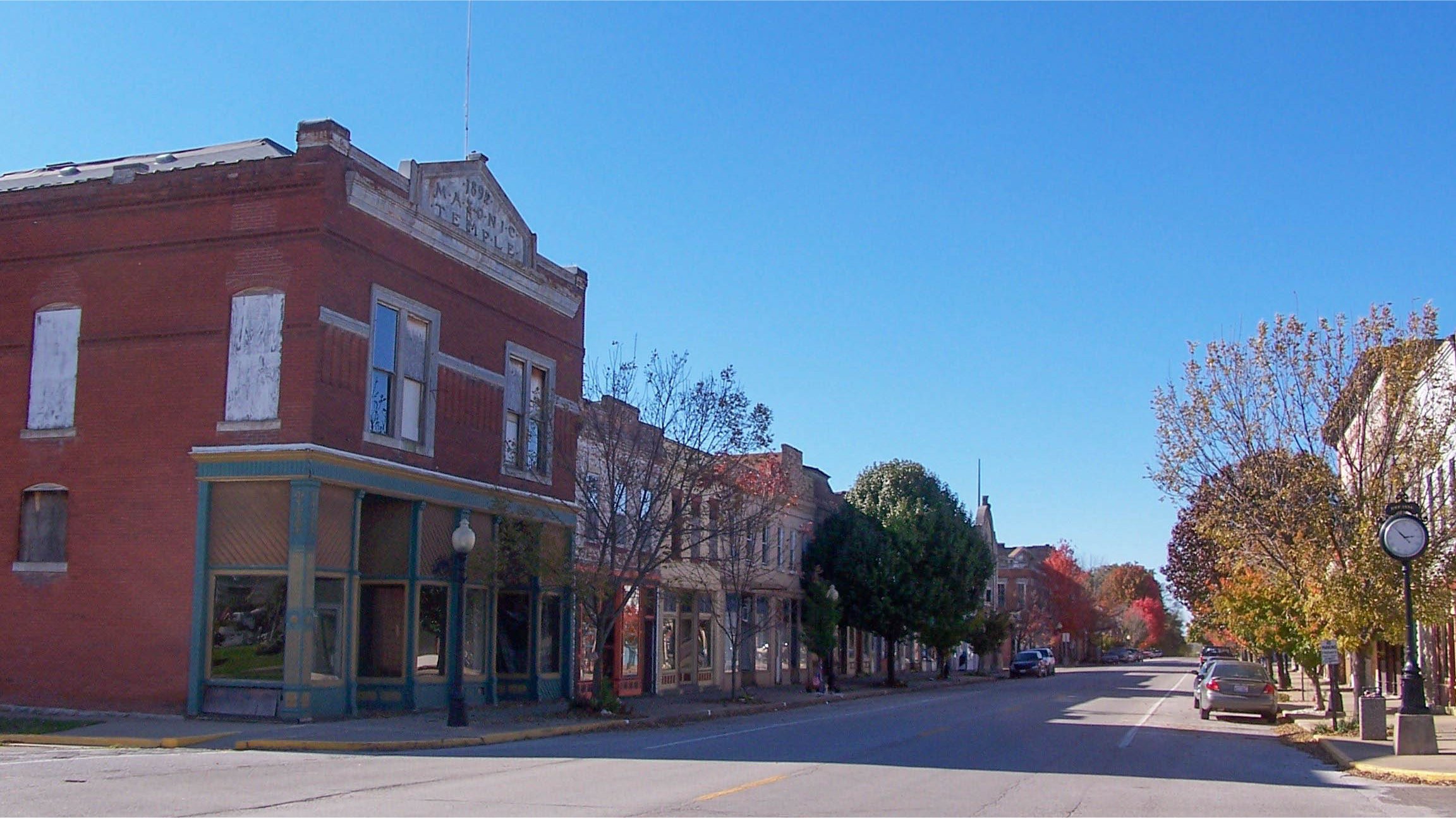Visitors Guide to Warsaw
Hancock County, Illinois
Main Street, downtown Warsaw
Fort Edwards State Memorial overlooking the Mississippi River
Warsaw is located on the bluffs in the bend of the Mississippi, opposite the mouth of the Des Moines River. The bluffs in front are abrupt, rising from the water's edge to a height of 50 or 100 feet, on which the town is built. The sites of the old Forts Johnson and Edwards are within the city limits. In 1814 during the war of 1812 Major Zachary Taylor, who later became the twelfth President of the United States, built a fort on the bluffs on the eastern bank of the Mississippi River across from the mouth of the Des Moines River and named it Fort Johnson after his friend Colonel Richard M. Johnson, who had claimed to have killed Tecumseh in hand to hand combat. American troops manned the fort for only a couple of weeks and burned it to the ground when they abandoned it when their supplies ran low. Fort Johnson is located on a high point 200 yards below Main Street, overlooking Albers & Co.'s steam mill, and immediately opposite the principal mouth of the Des Moines River. In the fall of 1815, a detachment of the 8th Infantry under Colonel Robert C. Nicholas ascended the Mississippi in keelboats, with the purpose of establishing a fort at or near Rock Island, to control the Sauk and Fox tribes. They were stopped by ice at the mouth of the Des Moines River in November and built rudimentary huts for winter quarters on the east bank of the Mississippi, calling their camp Cantonment Davis, which evolved into Fort Edwards, named after Ninian Edwards the Governor of the Illinois Territory. The fort was intermittently garrisoned and used as a fur trading post until it was finally abandoned in 1824. Fort Edwards occupied a bold bluff a half mile further up the river, and fronting toward Keokuk and the Iowa shore. The community of Warsaw was laid out in 1834 by speculators who thought the area would become important in manufacturing and shipping on the Mississippi River. In its early days it became the shipping center for the surrounding country and was one of the most important ports on the Mississippi River, being a port call for the steamboats on the St. Louis to Keokuk and St. Paul route.
During the 1840s the Mormons moved into Hancock County after being expelled from Missouri. As Mormon population grew, non-Mormons in Hancock County, especially in the towns of Warsaw and Carthage, felt threatened by the political power of the growing Mormon bloc-voting. Warsaw became a center of opposition to the Mormons at Nauvoo largely as a result of Thomas C. Sharp who edited the Warsaw Signal. In 1841 the Latter-day Saints did try to set up a settlement at Warren, a site just south of Warsaw. In 1841 Willard Richards moved to Warsaw to oversee the settlement of Warren, but with the antagonism fanned by Sharp and other problems, the settlement was fully abandoned in 1842. In 1844 Joseph Smith, Jr., founder of the Latter Day Saint movement and the mayor of Nauvoo, declare The Nauvoo Expositor a public nuisance, and ordered the paper's printing press destroyed after the Expositor's first and only issue was devoted to mainly to criticism of Smith. The destruction of the press was seen as an opportunity by critics such as Sharp who was openly using his paper to call for destruction of the Mormon Church. Agitated by Sharp and others, public sentiment held that the action was illegal and unconstitutional and the event ultimately led to the death of Smith and his brother Hyrum at the Carthage Jail. After Smith's death, the agitation against Mormons continued. The conflict escalated into what has sometimes been called the "Mormon War in Illinois." Opponents of the Mormons in Warsaw and Carthage began to call for the expulsion of the Latter Day Saints from Illinois. In October of 1844, a great gathering was announced in Warsaw. Although it was purported to be a "wolf hunt," it was known that the "wolves" to be hunted were the Mormons. Illinois Governor Thomas Ford became aware of it and had to send sent militia troops to disperse the gathering. By the end of 1845 Mormon leaders negotiated a truce so that the they could prepare to abandon the Nauvoo. The winter of 1845-46 saw the enormous preparations for the Mormon Exodus via the Mormon Trail. In early 1846, the majority of the Latter Day Saints left Hancock County.
Warsaw was incorporated as a city in 1853 and by 1875 had reached a population of 20,000. Industries during this prosperous period included clam shell button making, flour milling, the manufacture of fine woolen cloth, and farm machinery. Today the population is about 2,000. Main Street, which is the principal street, retains many of the earmarks of an early, prosperous American frontier town and the downtown area was designated a historic district in 1977.The Warsaw Brewery, which opened in 1861 and closed in 1971, has reopened as a bar and microbrewery. There are 3 inexpensive self-guided tours, full of history, maps and pictures that can be picked up at any of the local establishments.












